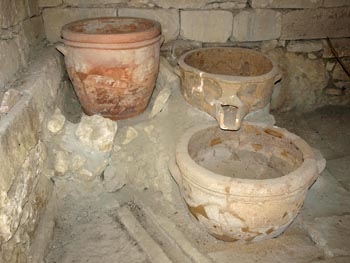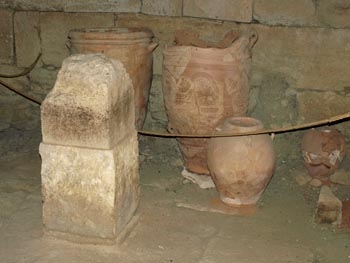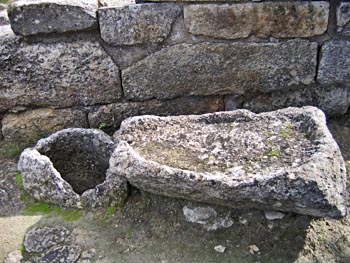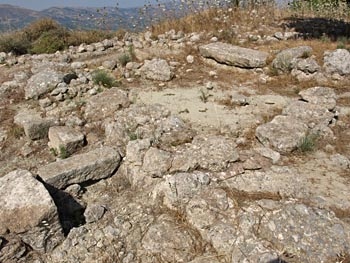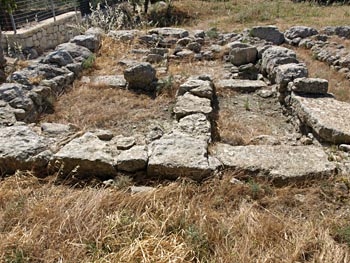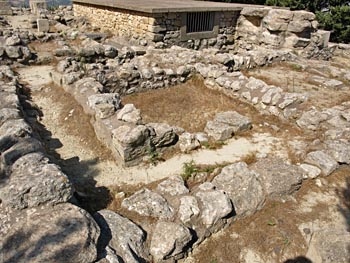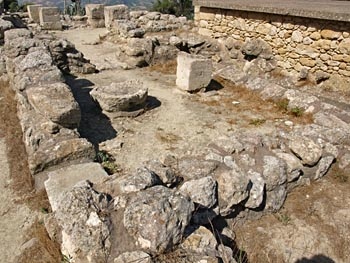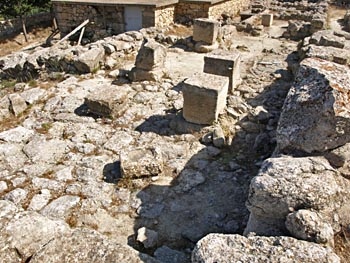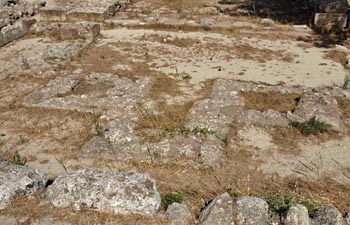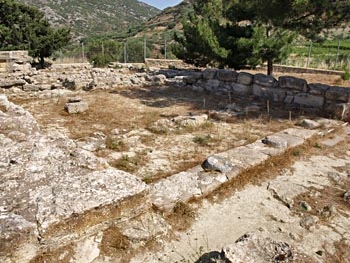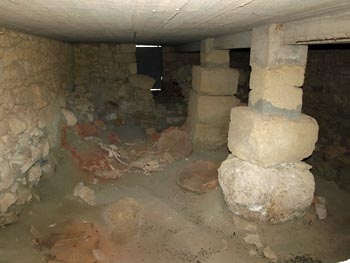
A Late Minoan IA complex
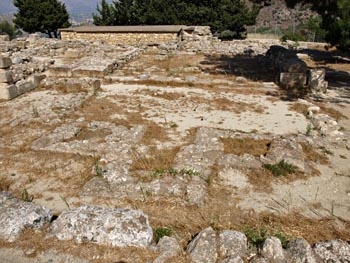
View of the east part of the site with the outline of the tripartite shrine at the bottom of the picture
Vathypetro lies some five kilometres south of Archanes at the foot of the southern end of Mount Iuktas in Central Crete and was probably on the Minoan route from Knossos to the Messara plain in the south of the island. The site was excavated by S. Marinatos from 1949-53 and again in 1955-6. Since he intended to locate a local museum on the site the remains were reconstructed and modified, making it difficult for archaeologists to piece together the original structure of the buildings on the site. The Vathypetro complex was constructed around 1580 BCE at the beginning of the Late Minoan IA period and badly damaged around 1550 BCE, perhaps by an earthquake. The south sector of the building, which includes a wine press, was rebuilt as a farmhouse and industrial centre after the 1550 BCE destruction and was finally destroyed around 1470 BCE.
The Vathypetro complex is not an isolated, independent structure as it forms part of a small settlement stretching over three hills. Unfortunately vineyard cultivation has destroyed the remains immediately surrounding the site. However, it is likely that the complex was the most important building on the site since this is the only place where ashlar masonry is to be found in the area. According to Driessen and Sakellarakis, there are in fact two buildings on the site which lie east and west of a narrow corridor. Both buildings are orientated north-south which led Marinatos to believe that the building was planned as a palace.
It is not known whether the east and west buildings were constructed at the same time. But since the building techniques and materials were different in the two cases this suggests that they may have been built at different times with the east building representing a second phase, dating from Late Minoan IB.
The original west building was a medium-sized ashlar structure similar to, for example, Nirou Chani or Myrtos-Pirgos. It included a series of palatial features including orientation, porticos, a west facade, halls with light wells, a possible lustral basin, a pillar crypt and pillar magazines as well as a courtyard. The later wine press is now located in the area which would have been the pillar crypt. Room 24 may well have been a Minoan Hall during the first phase, although in the second phase it seems the room was subdivided and used for the production of pottery as suggested by the pottery wheels found there.
Unlike today, where the approach is from the north, the west building would originally have been approached from the west, uphill along a paved street which passed west of the building. Visitors would first pass room 19 then the niche with bench and on past the ashlar facade of the pillar magazine (room 10) before arriving at the entrance courtyard with its irregularly placed pillars. It is possible that areas 7 and 8 were a staircase leading to upper floor rooms along the west facade of the building. Finds from rooms on the West side of the west building included brightly painted wall plaster, carved stone lamps, a bronze idol, part of a bronze vessel, some gold leaf and three seals.
Driessen and Sakellarakis support the view that a tripartite shrine, identified by Marinatos, was built on the site during the first phase of building, but this remains a controversial point as a number of prominent archaeologists do not agree that there is evidence for a tripartite shrine. If it is in fact a tripartite shrine, it is the only true architectural example of such a shrine which is only known to us from the frescoes and other artefacts. It has been established that the alignment of the northern niche of the tripartite shrine exactly agreed with the spring and autumn equinoxes. This suggests some connection between religious ritual and agriculture and Driessen and Sakellarakis even go so far as to suggest that the position of the tripartite shrine at Vathypetro may have been one of the reasons that the site was chosen for the location of the villa in the first place.
An earthquake interrupted the original construction work. Evidence for this includes the use of building blocks in places other than those where they were originally meant to be used and patched up walls. In the second phase the tripartite shrine was given a temenos wall which closed off access to the shrine from the west. Several large thresholds were created in the western building and it is thought that these must have been created in the second phase. Since they resemble the thresholds in the eastern building this argues for a later date of construction for this building.
Three areas contained olive presses and a large number of pithoi were also discovered. There was also a potter's kiln on the site. A finely paved area was used for storage, and the production of wine and textiles. The wine-press can still be seen. Many clay loom weights were also found. This gives a pretty clear indication of the basic economic activity conducted by the inhabitants of the house. Castleden suggests that the original building may have started off as a temple or a religious centre of some kind, only changing its nature after the first destruction. Driessen and Sakellarakis consider the Vathypetro complex (their term) as the main building of a large village. In its first phase its functions included administrative, ritual, residential and storage. In the second phase it was given over to domestic agricultural and industrial production.
Sinclair Hood has suggested that it might have been the summer residence of the King of Archanes. (Summer residences for Minoan kings have been suggested at various sites, including Agia Triada for the King of Phaistos and Archanes itself for the King of Knossos, though the idea seems to have gone out of fashion recently). However, Vathypetro may well have simply been a manor with its own domestic shrines.
The site is open all year round and entrance is free. For visitors to Archanes it is well worth the five-kilometre drive just to see the indoor wine press alone, and of course the spectacular views of the Iuktas mountain and the view to the south.


